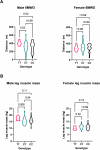Association of bradykinin receptor 2 (BDKRB2) variants with physical performance and muscle mass: Findings from the LACE sarcopenia trial
- PMID: 39093910
- PMCID: PMC11296637
- DOI: 10.1371/journal.pone.0307268
Association of bradykinin receptor 2 (BDKRB2) variants with physical performance and muscle mass: Findings from the LACE sarcopenia trial
Abstract
Introduction: Understanding genetic contributors to sarcopenia (age-related loss of muscle strength and mass) is key to finding effective therapies. Variants of the bradykinin receptor 2 (BDKRB2) have been linked to athletic and muscle performance. The rs1799722-9 and rs5810761 T alleles have been shown to be overrepresented in endurance athletes, possibly due to increased transcriptional rates of the receptor. These variants have been rarely studied in older people or people with sarcopenia.
Methods: We performed a post hoc sub-study of the Leucine and ACE (LACE) inhibitor trial, which enrolled 145 participants aged ≥70 years with low grip strength and low gait speed. Participants' blood samples were genotyped for rs179972 using TaqMan and rs5810761 by amplification through Hotstar Taq. Genotypes were compared with outcomes of physical performance and body composition measures.
Results: Data from 136 individuals were included in the analysis. For rs1799722 the genotype frequency (TT: 17, CC: 48, CT: 71) remained in Hardy-Weinberg Equilibrium (HWE p = 0.248). There was no difference between the genotypes for six-Minute Walk Distance (6MWD) or Short Physical Performance Battery (SPPB). Men with the TT genotype had a significantly greater 6MWD than other genotypes (TT 400m vs CT 310m vs CC 314m, p = 0.027), and greater leg muscle mass (TT 17.59kg vs CT 15.04kg vs CC 15.65kg, p = 0.007). For rs5810761, the genotype frequency (-9-9: 31, +9+9: 43, -9+9: 60) remained in HWE (p = 0.269). The +9+9 genotype was associated with a significant change in SPPB score at 12 months (-9-9 0 vs -9+9 0 vs +9+9-1, p<0.001), suggesting an improvement. In men, the -9-9 genotype was associated with lower arm fat (-9-9 2.39kg vs -9+9 2.72kg vs +9+9 2.76kg, p = 0.019).
Conclusion: In men, the rs1799722 TT genotype was associated with longer 6MWD and greater leg muscle mass, while the rs5810761 -9-9 genotype was associated with lower arm fat mass.
Copyright: © 2024 Shrestha et al. This is an open access article distributed under the terms of the Creative Commons Attribution License, which permits unrestricted use, distribution, and reproduction in any medium, provided the original author and source are credited.
Conflict of interest statement
The authors have declared that no competing interests exist.
Figures


References
-
- Cruz-Jentoft AJ, Sayer AA. Sarcopenia. The Lancet. 2019. Jun;393(10191):2636–46. - PubMed
Publication types
MeSH terms
Substances
LinkOut - more resources
Full Text Sources
Miscellaneous

